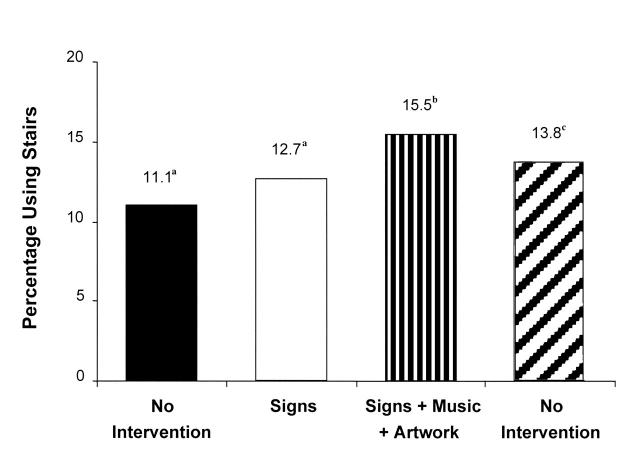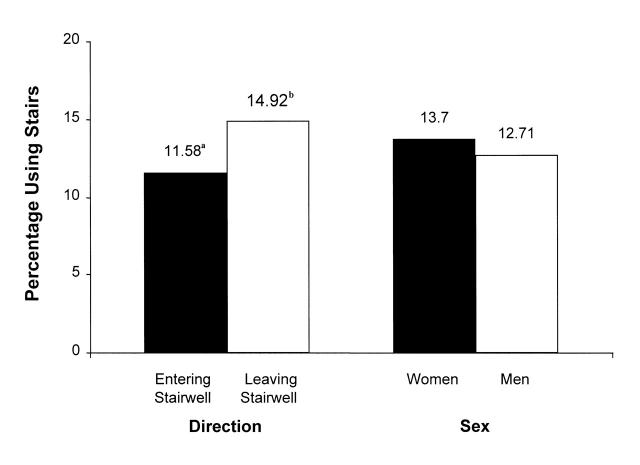Abstract
Objectives. This study assessed the impact on stair use of improving the attractiveness of a stairwell.
Methods. Observations of stair usage were made in a university building during baseline, 2 interventions, and follow-up. The first intervention involved signs; the second intervention added artwork and music in the stairwell.
Results. More participants used the stairs during the music and artwork intervention than at baseline or when signs alone were used.
Conclusions. Improving the aesthetic qualities of a stairwell can increase rates of stair usage in a public building. Designs for buildings should take accessibility and aesthetic issues into consideration.
Epidemiologic studies show that a sedentary lifestyle is associated with a higher risk of disease and mortality.1 Yet, only a small minority of the population engages in regular exercise.2 An environment that encourages “lifestyle activity” may influence a large portion of the inactive population. Three previous studies showed that signs placed at a decision point between stairs and an escalator can increase stair usage.3–5 The present study, conducted during 1997, evaluated the efficacy of an intervention designed to increase the aesthetic attractiveness of a stairwell in addition to providing signs with health messages to increase stair use.
METHODS
Design
This study consisted of observations of stair and elevator usage during baseline, 2 interventions, and a follow-up. The baseline phase lasted 3 weeks, and each subsequent phase lasted 4 weeks.
Site
The University of Minnesota School of Public Health building, with 8 floors and approximately 700 full- and part-time employees, was chosen as the intervention site owing to the proximity of the elevator and the stairwell. Of note, the building required a key card to access the stairwell but not the elevator.
Observation of Usage
Four students directly observed elevator and stair use. Observers were inconspicuously located at a decision point at the foot of the stairs and elevator in a lobby area 3 days per week (Monday, Wednesday, and Friday) and 3 hours per day.
Observers kept count of the number of people entering and leaving the stairwell or elevator and recorded their sex and direction of usage (entering or exiting). Those carrying items larger than a briefcase or pushing carts were not counted. On each day, the percentage of individuals using the stairs was computed.
The total number of observations made during the study was 35 475. Interobserver agreement was greater than 98%.6
Interventions
Signs.
This intervention included a stand-up floor sign reading “Take the stairs for your health”; the sign was placed at the decision point for the stair and elevator. The same sign was placed above all of the elevator buttons in the building. Signs were also placed on the stairwell doors to identify that the door led to the stairwell.
Music and artwork.
In the second intervention, the signs remained in place, and artwork and music were added in the stairwell. The artwork that hung on the stairwell walls was changed every week. A compact disc player placed between the second and third floors of the stairwell repeated music throughout the day. The music was changed daily and could be heard on all floors of the stairwell.
Analyses
In preliminary analyses, we evaluated correlations between observations taken on the same days, in the same weeks, and during the same phases. None of these correlations were significant, indicating that observations could be analyzed as independent.
We then performed a 1-way analysis of variance (ANOVA) with period as the grouping factor. In follow-up analyses, we collapsed the categories across sex or direction of travel. Next, we performed a 2-way ANOVA, using both main effects and the 2-way interaction.
Because neither interaction proved significant, we followed those 2-way ANOVAs with models that retained the main effects but eliminated the interaction terms. In both the primary and secondary analyses, we used Tukey pairwise comparisons to guide our interpretation of the results if the effects of interest were significant at P < .05.
RESULTS
Intervention Status
There was a main effect for intervention (F3,131 = 10.50, P < .01; see Figure 1 ▶), and there were significant differences between baseline and the music–artwork intervention (P < .01), baseline and follow-up (P < .01), the music–artwork intervention and the intervention involving signs only (P < .01), and the music–artwork intervention and follow-up (P = .03). There were no significant differences between baseline and the intervention involving signs only or between the latter intervention and follow-up.
FIGURE 1—
Percentages of people using stairs during each phase of the study.
Note. Percentages with unshared superscripts differ significantly at P < .05.
Direction of Travel
There were main effects for intervention (F3,265 = 12.36, P < .01) and direction (F1,265 = 45.99, P < .01; see Figure 2 ▶). Participants were more likely to exit the stairwell (mean = 14.92%, SE = 0.35%) than to enter the stairwell (mean = 11.58%, SE = 0.35%; P < .01).
FIGURE 2—
Percentages of people, by direction and sex, using stairs during the 15 weeks of the study.
Note. Percentages with unshared superscripts differ significantly at P < .05.
Sex
There were main effects for intervention (F3,265 = 12.93, P < .01) and sex (F1,265 = 4.11, P < .05; see Figure 2 ▶). Women were more likely to use the stairs (mean = 13.70%, SE = 0.35%) than were men (mean = 12.71%, SE = 0.35%; P = .04).
DISCUSSION
Our results showed that beyond the effect of signs alone, improving the aesthetic qualities of a stairwell can significantly increase stair use. In this study, a greater proportion of women took the stairs, and a greater proportion of the participants exited than entered the stairwell, presumably indicating more downward than upward stair travel. Neither intervention differentially affected men or women or direction of travel.
The music, artwork, and signs significantly increased the proportion of participants who used the stairs. Although the raw percentages of participants using the stairs seem small, an informal survey of participants showed that approximately one third did not have a key card and could not use the stairwell. If a third of the total observations were removed, the percentages of eligible participants who used the stairs would be much larger.
We cannot identify whether it was the aesthetic appeal of the music and artwork or the novelty of the intervention that influenced stair usage. We also cannot differentiate between the effect of the music and that of the artwork alone. Participants may have used the stairwell as a result of the improved aesthetics, or they may have done so because they were interested in the changing music and artwork.
The results of this study have implications for building design and physical activity. Buildings should be designed with attractive stairwells that are accessible to the general population. Our findings show that environmental changes can significantly increase the number of individuals in a building who use the stairs.
Acknowledgments
This study was supported by grant 1P30-DK50456 from the National Institute of Diabetes and Digestive and Kidney Diseases to Robert Jeffrey and by a student research award from the Division of Epidemiology, School of Public Health, University of Minnesota, to Kerri Boutelle.
K. N. Boutelle planned and executed the study, analyzed the data, and wrote the report. R. W. Jeffery designed the study, supervised the data analysis, and contributed to the writing. D. M. Murray codesigned the study, collected and analyzed the data, and contributed to the writing. M. K. H. Schmitz assisted in the study design and execution and contributed to the writing.
Peer Reviewed
References
- 1.Physical Activity and Health: A Report of the Surgeon General. Atlanta, Ga: Centers for Disease Control and Prevention; 1996.
- 2.Healthy People 2000: National Health Promotion and Disease Prevention Objectives. Washington, DC: US Dept of Health and Human Services; 1991. DHHS publication PHS 91-50212.
- 3.Brownell KD, Stunkard AJ, Albaum JM. Evaluation and modification of exercise patterns in the natural environment. Am J Psychiatry. 1980;137:1540–1545. [DOI] [PubMed] [Google Scholar]
- 4.Blamey A, Mutrie N, Aichison T. Health promotion by encouraged use of stairs. BMJ. 1995;311:289–290. [DOI] [PMC free article] [PubMed] [Google Scholar]
- 5.Anderson RE, Franckowiak SC, Snyder J, Bartlett SJ, Fontaine KR. Can inexpensive signs encourage the use of stairs? Results from a community intervention. Ann Intern Med. 1998;129:363–369. [DOI] [PubMed] [Google Scholar]
- 6.Repp AC, Dietz DE, Boles SM, Dietz SM, Repp CG. Differences among common methods for calculating interobserver agreement. J Appl Behav Anal. 1976;9:109–113. [DOI] [PMC free article] [PubMed] [Google Scholar]




